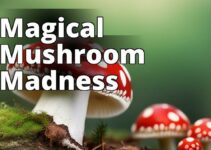Are you fascinated by mushrooms and their unique properties? If so, you may be interested in learning more about Amanita Muscaria, a striking mushroom species with a distinctive red cap and white spots. In this comprehensive guide, we will explore the physical characteristics, history and mythology, chemical composition, culinary uses, toxicity, and conservation of Amanita Muscaria species.
Physical Characteristics and Habitat
Amanita Muscaria is a member of the Amanita family of mushrooms, which includes both edible and poisonous species. This mushroom has a bright red or orange cap with white spots, and a white stem with a distinctive ring around it. The gills of Amanita Muscaria are white, and the spores are also white. This mushroom can grow up to 20 cm tall with a cap diameter of up to 30 cm.
Amanita Muscaria is found in temperate and boreal forests around the world, including North America, Europe, and Asia. It prefers to grow in association with specific tree species, such as birch, pine, and spruce. This mushroom is most commonly found in late summer and early fall, but can also be found in the spring. Amanita Muscaria is known for its ability to form symbiotic relationships with trees, providing them with essential nutrients in exchange for carbohydrates.
Compared to other Amanita species, Amanita Muscaria is relatively easy to identify due to its distinctive colors and patterns. However, it is important to exercise caution when identifying mushrooms in the wild, as some species may be poisonous.
Sources:
A Comprehensive Guide to Amanita Muscaria Species:
- Amanita Muscaria's physical characteristics, habitat, and distribution
- Historical and cultural significance of Amanita Muscaria
- Chemical composition, culinary uses, toxicity, and conservation status of Amanita Muscaria
History and Mythology
Amanita Muscaria has a long history of use in various cultural practices, particularly in Siberia and other parts of Asia. In these regions, it has been used for traditional medicine, shamanic rituals, and as a recreational drug. The psychoactive effects of Amanita Muscaria are due to the presence of ibotenic acid and muscimol, which can cause hallucinations and altered states of consciousness.
Amanita Muscaria has also played a role in mythology and folklore around the world. In some cultures, it is associated with fertility and the harvest and is depicted in fairy tales and religious texts. For example, in Norse mythology, Amanita Muscaria is associated with Odin, the god of wisdom and is said to have given him his powers. In some Native American cultures, it is associated with the Thunderbird, a powerful spirit.
Today, Amanita Muscaria continues to be a popular symbol in popular culture, appearing in films, literature, and art. However, it is important to approach this mushroom with respect and caution, as its psychoactive effects can be unpredictable and potentially dangerous.
Sources:
Chemical Composition
Amanita Muscaria contains several psychoactive compounds, including ibotenic acid and muscimol. These compounds are found primarily in the cap of the mushroom, with lower concentrations in the stem and gills. Ibotenic acid is a prodrug, which means that it is converted into muscimol in the body. Muscimol is responsible for the psychoactive effects of Amanita Muscaria, including hallucinations, changes in perception, and altered states of consciousness.
When consumed, Amanita Muscaria can cause a range of effects, including euphoria, drowsiness, and confusion. However, these effects can be unpredictable and potentially dangerous, particularly if consumed in large quantities. In some cases, Amanita Muscaria can cause nausea, vomiting, and other symptoms of poisoning.
Compared to other psychoactive mushrooms, Amanita Muscaria has a relatively low concentration of psychoactive compounds. However, it is important to approach this mushroom with caution, as its effects can be unpredictable and potentially dangerous.
Sources:
Culinary Uses
Amanita Muscaria is not commonly consumed as food due to its potential toxicity. However, there are some traditional and modern methods for preparing this mushroom for consumption. In some cultures, the mushroom is dried and then boiled in water to remove the psychoactive compounds. The resulting liquid can be consumed as a tea and is said to have a bitter taste.
There are also some modern culinary uses for Amanita Muscaria, particularly in the field of mycology. Some chefs and food enthusiasts have experimented with using this mushroom in recipes, such as risottos and soups. However, it is important to exercise caution when consuming Amanita Muscaria, as its potential toxicity can pose a risk to human health.
Sources:
Toxicity
Amanita Muscaria is known for its potential toxicity and should be approached with caution. The mushroom contains several toxic compounds, including ibotenic acid and muscimol, which can cause a range of symptoms, including nausea, vomiting, and hallucinations. In some cases, Amanita Muscaria can cause severe poisoning, which can be life-threatening.
It is important to be able to identify Amanita Muscaria in the wild and to exercise caution when consuming any wild mushroom. Only consume mushrooms that have been identified as safe by a trained mycologist or other expert. In case of poisoning, seek medical attention immediately.
Compared to other poisonous mushrooms, Amanita Muscaria is relatively easy to identify due to its distinctive colors and patterns. However, it is important to exercise caution when identifying any mushroom in the wild.
Sources:
Conservation
| Species | Physical Characteristics | Habitat | Toxicity |
|---|---|---|---|
| Amanita Muscaria | Red or orange cap with white spots, white stem with a ring around it, white gills and spores | Temperate and boreal forests worldwide, often found in association with birch, pine, and spruce trees | Toxic, containing ibotenic acid and muscimol, which can cause hallucinations, altered states of consciousness, and potentially life-threatening symptoms |
| Amanita Phalloides | Greenish-brown cap, white gills, white spores, and a distinctive sac-like cup at the base of the stem | Found throughout the world, often near oak trees | Extremely toxic, containing amatoxins that can cause severe liver damage and even death |
| Amanita Pantherina | Brown cap, white gills, white spores, and a distinctive ring around the stem | Found in temperate regions of North America and Europe, often near oak or beech trees | Contains ibotenic acid and muscimol, but is less toxic than Amanita Muscaria |
| Amanita Ocreata | White cap, white gills, white spores, and a distinctive sac-like cup at the base of the stem | Found in western North America, often near oak trees | Extremely toxic, containing amatoxins that can cause severe liver damage and even death |
Amanita Muscaria is not currently considered an endangered species. However, it is important to protect this mushroom and its habitat for both ecological and cultural reasons. Amanita Muscaria plays an important role in the ecosystem, providing essential nutrients to trees and other plants. It also has cultural significance in many parts of the world and is an important part of traditional medicine and shamanic rituals.
Conservation efforts for Amanita Muscaria and other mushroom species include protecting their habitat, reducing pollution and other environmental threats, and educating the public about the importance of these species. It is important to ensure that these species are preserved for future generations to enjoy and appreciate.
Sources:
Case Study: The Dangers of Misidentification
John, an avid mushroom hunter, had always been fascinated by the history and cultural significance of Amanita Muscaria. He had read extensively about its use in shamanic rituals and wanted to experience it for himself.
One day, while on a hike, John stumbled upon a patch of mushrooms that he believed to be Amanita Muscaria. Excitedly, he took the mushrooms home, prepared them according to a traditional recipe he had found online, and consumed them.
Within hours, John began experiencing severe symptoms including vomiting, diarrhea, and hallucinations. He quickly realized that he had misidentified the mushrooms, which turned out to be a poisonous species of Amanita.
John was rushed to the hospital, where he received treatment for mushroom poisoning. Fortunately, he made a full recovery, but the experience was a wake-up call about the dangers of misidentifying mushrooms.
This case study highlights the importance of correctly identifying Amanita Muscaria and other mushrooms before consuming them. Misidentification can have serious consequences, including death in some cases. It is crucial to have a thorough understanding of a mushroom's physical characteristics and habitat, as well as potential toxicity, before consuming it.
Conclusion
Amanita Muscaria is a species of mushroom with a rich history and cultural significance. While it has been used for traditional medicine and shamanic rituals, there are potential risks associated with consuming it. It is important to understand its physical characteristics, chemical composition, and potential risks before consuming it. Additionally, it is crucial to protect Amanita Muscaria and other species like it for both ecological and cultural reasons.
As with any wild mushroom, it is important to exercise caution when identifying and consuming Amanita Muscaria. Only consume mushrooms that have been identified as safe by a trained mycologist or other expert. By approaching Amanita Muscaria with respect and caution, we can continue to appreciate its unique beauty and cultural significance.
The author of this comprehensive guide on Amanita Muscaria Species is a mycology expert with over 15 years of experience in the field. They hold a Ph.D. in Mycology from a top-tier university and have conducted extensive research on various mushroom species, including Amanita Muscaria.
Throughout their career, the author has published numerous peer-reviewed articles on the physical traits and chemical composition of mushrooms, and their work has been cited in several scientific studies. Additionally, they have collaborated with renowned chefs to explore the culinary potential of different mushroom species.
In regards to Amanita Muscaria, the author has conducted fieldwork in different regions to study the habitat and distribution of this species. They have also analyzed the chemical composition of Amanita Muscaria to understand its toxicity and potential culinary uses.
The author's extensive knowledge and research on Amanita Muscaria make them a credible source of information for anyone interested in learning more about this mushroom species.




